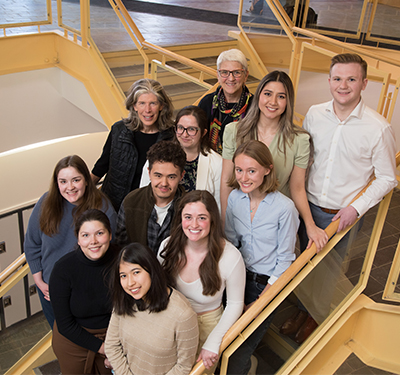
This past semester, eight students worked as research assistants with the Plutonium Project, an interdisciplinary research project in STU’s Environment and Society Program led by Dr. Janice Harvey and Dr. Susan O’Donnell, along with Dr. Andy Secord – Economics, Dr. Laura Levick and Dr. Shaun Narine – Political Science.
With majors ranging from Environment and Society to Criminology and everything in between, students Alex Compton, Alexandra Guitard, Chris Roddis, Emily Green, Emma Fackenthall, Erin Hurley, Maria Guerrero, and Valeria Solis formed a dynamic interdisciplinary team.
As part of its climate action strategy, the New Brunswick government is supporting two private companies with office in Saint John, Moltex (UK-based) and ARC (US-based), to develop designs for small modular nuclear reactors (SMRs) to be built on the site of the existing NB Power Point Lepreau Nuclear Generating Station on the Bay of Funday. Unlike those planned for other provinces, these SMR designs involve breeding or separating plutonium, one of Earth’s the most dangerous substances.
“Researching plutonium reprocessing in New Brunswick is essential to understanding the risks this activity poses to the health and safety of people in the province,” said research assistant Maria Caridad Guerrero, a fourth-year honours student in Political Economy. “As a team, we worked collectively to uncover the reality of nuclear energy in Canada in hopes of bringing awareness and inspiring further research that can place these projects under scrutiny.”
Working in pairs, the student researchers analyzed the New Brunswick government’s initiative through the lenses of media discourse, global security, political economy, and environmental, health and economic impacts, as well as Indigenous perspectives.
The project team met weekly to discuss their findings and decide on the next steps. They also meet by video conference with international experts who answered their technical and policy questions. At the end of the project, the students prepared research posters they displayed on campus and made a short video explaining what they had learned.
Developing Skills for Critical and Informed Interpretation
The students presented the results of their work at STU’s premier student research event, the annual Student Research and Ideas Fair. Their presentations demonstrated the value of collaborative, team-based research, critical and informed interpretation, and clear public speaking—all key components of a liberal arts education at STU.
According to Erin Hurley, a third-year student studying Environment and Society and Journalism, the time to transition away from fossil fuels in the face of the climate crisis is now, and the main discourse around alternative energy sources is nuclear versus renewables. “New Brunswick is interested in engaging in plutonium reprocessing with the proposed SMRs, but reprocessing has many implications in terms of radioactive waste and nuclear weapons proliferation.”
“It is essential to conduct plutonium research to raise awareness of the dangers of reprocessing, debunk misinformation such as the labeling of nuclear as ‘clean’, and bring attention to the need for a just transition to energy sources that will not cause more unprecedented crises than we are already dealing with,” she added.
Plutonium Project and the RAVEN and CEDAR Research Projects
The Plutonium Project was part of the Rural Action and Voices for the Environment (RAVEN) research funded by the Social Sciences and Humanities Research Council and based at the Department of Sociology at the University of New Brunswick where Dr. O’Donnell is an adjunct professor and RAVEN lead investigator. Dr. Harvey is a co-investigator on RAVEN.
For the last three years, RAVEN has been investigating technologies proposed for climate action, including the plan to build more nuclear reactors in the province.
Background on Plutonium
Plutonium is formed when uranium atoms are split or fissioned inside a nuclear reactor and comprise one of many radioactive components of spent nuclear fuel, which becomes nuclear waste. Plutonium can be made into new nuclear reactor fuel by reprocessing spent reactor fuel as in the Moltex SMR design or breeding plutonium as in the ARC design.
Plutonium is also used as the explosive in nuclear bombs. Because of nuclear weapons proliferation concerns, the Canadian government has maintained a de facto ban on plutonium reprocessing since the 1970s, following a ban imposed in the US by President Jimmy Carter. If their plutonium plans are approved, these New Brunswick projects would reverse that longstanding policy.
/filters:format(webp)/prod01/stuca/media/stu/site-assets/images/features/Internship-Lauren-Feature.jpg)
/filters:format(webp)/prod01/stuca/media/stu/site-content/news/BEd.jpg)
/filters:format(webp)/prod01/stuca/media/stu/site-assets/images/features/map_system_news.jpg)